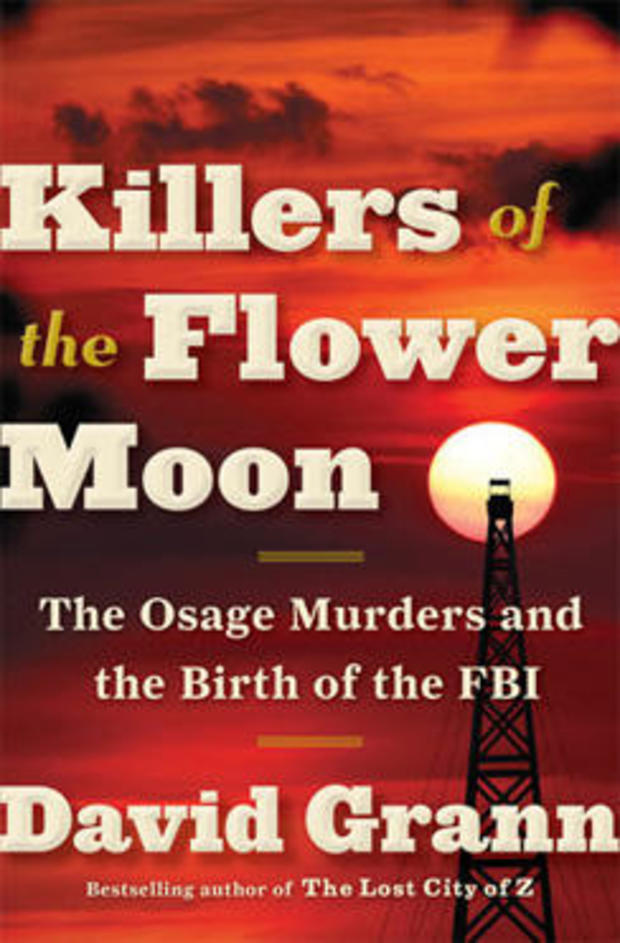Book excerpt: "Killers of the Flower Moon"
The latest New York Times bestseller from author David Grann ("The Lost City of Z") tells the terrible true story of how a vast oil deposit found on an Indian reservation in the 1920s precipitated fraud and murder.
The seemingly worthless land of the Osage Nation, a remote territory in Oklahoma, turned out to harbor some of the largest oil deposits in the United States. Almost overnight, the Osage became some of the richest people per capita in the world. But the U.S. government -- supposedly to protect the Osage from mismanaging their new-found wealth -- assigned white guardians to oversee the oil revenues. Abuse and fraud became rampant, as did, Grann found, homicide.
Read an excerpt from "Killers of the Flower Moon: The Osage Murders and the Birth of the FBI" below.
- Revisiting the "Reign of Terror" on the Osage Nation ("Sunday Morning," 04/30/17)
The Vanishing
In April, millions of tiny flowers spread over the blackjack hills and vast prairies in the Osage territory of Oklahoma. There are Johnny-jump-ups and spring beauties and little bluets. The Osage writer John Joseph Mathews observed that the galaxy of petals makes it look as if the "gods had left confetti." In May, when coyotes howl beneath an unnervingly large moon, taller plants, such as spiderworts and black-eyed Susans, begin to creep over the tinier blooms, stealing their light and water. The necks of the smaller flowers break and their petals flutter away, and before long they are buried underground. This is why the Osage Indians refer to May as the time of the flower-killing moon.
On May 24, 1921, Mollie Burkhart, a resident of the Osage settlement town of Gray Horse, Oklahoma, began to fear that something had happened to one of her three sisters, Anna Brown. Thirty-four, and less than a year older than Mollie, Anna had disappeared three days earlier. She had often gone on "sprees," as her family disparagingly called them: dancing and drinking with friends till dawn. But this time one night had passed, and then another, and Anna had not shown up on Mollie's front stoop as she usually did, with her long black hair slightly frayed and her dark eyes shining like glass. When Anna came inside, she liked to slip off her shoes, and Mollie missed the comforting sound of her moving, unhurried, through the house. Instead, there was a silence as still as the plains.
Mollie had already lost her sister Minnie nearly three years earlier. Her death had come with shocking speed, and though doctors had attributed it to a "peculiar wasting illness," Mollie harbored doubts. Minnie had been only twenty-seven and had always been in perfect health.
Like their parents, Mollie and her sisters had their names inscribed on the Osage Roll, which meant that they were among the registered members of the tribe. It also meant that they possessed a fortune. In the early 1870s, the Osage had been driven from their lands in Kansas onto a rocky, presumably worthless reservation in northeastern Oklahoma, only to discover, decades later, that this land was sitting above some of the largest oil deposits in the United States. To obtain that oil, prospectors had to pay the Osage for leases and royalties. In the early 1900s, each person on the tribal roll began receiving a quarterly check. The amount was initially for only a few dollars, but over time, as more oil was tapped, the dividends grew into the hundreds, then the thousands. And virtually every year the payments increased, like the prairie creeks that joined to form the wide, muddy Cimarron, until the tribe members had collectively accumulated millions and millions of dollars. (In 1923 alone, the tribe took in more than thirty million dollars, the equivalent today of more than four hundred million dollars.) The Osage were considered the wealthiest people per capita in the world. "Lo and behold!" the New York weekly Outlook exclaimed. "The Indian, instead of starving to death ... enjoys a steady income that turns bankers green with envy."
Excerpted from "Killers of the Flower Moon: The Osage Murders and the Birth of the FBI" by David Grann Copyright © 2017 by David Grann. Excerpted by permission of Doubleday, a division of Penguin Random House, Inc. All rights reserved. No part of this excerpt may be reproduced or reprinted without permission in writing from the publisher.
For more info:
- "Killers of the Flower Moon: The Osage Murders and the Birth of the FBI" by David Grann (Doubleday); Also available in eBook, Audio Download and Audio CD formats
- davidgrann.com




